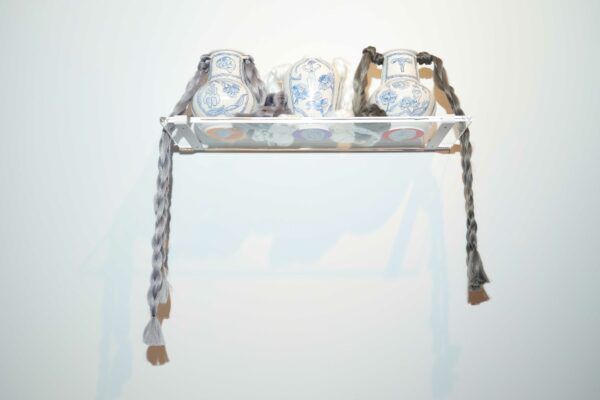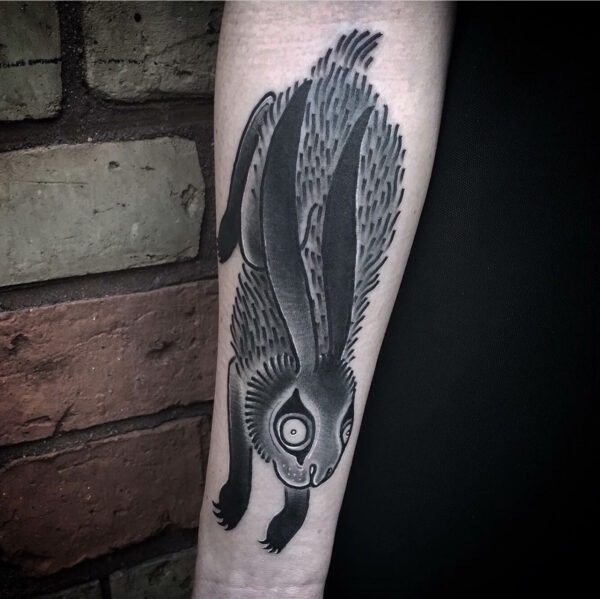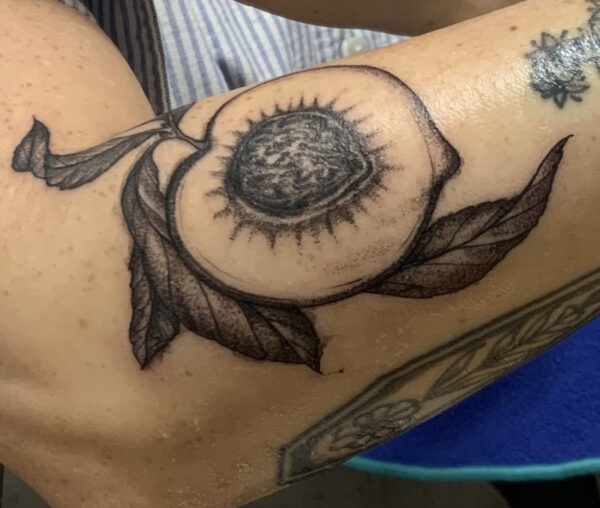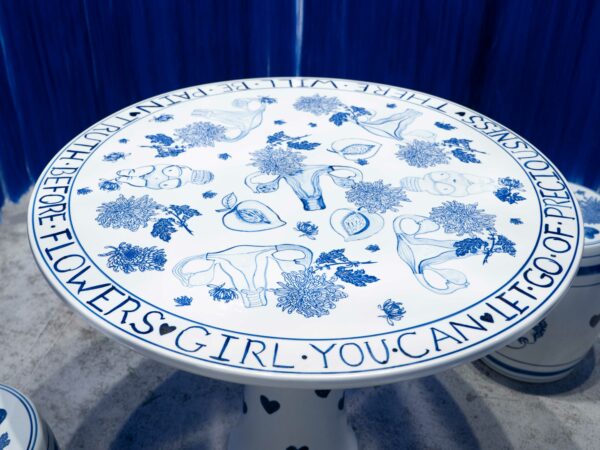Jennifer Ling Datchuk was born in Warren, Ohio and raised in Brooklyn, New York by her Chinese mother and her Caucasian father, who is of Russian and Irish descent. Datchuk holds an MFA in Artisanry from the University of Massachusetts Dartmouth and a BFA in Crafts from Kent State University.
In her work, she explores her identity as a woman — a Chinese and American woman — through objects that are often associated with traditional women’s work. Using materials like porcelain, textiles, and hair, she raises questions about femininity, intersectionality, and personal history.
Datchuk also focuses on how non-Western bodies are commodified and sold. When racialized bodies become a source of economic gain, we see the commodification of race, in which bodies are turned into objects, merely becoming things to be consumed and owned.
These ideas in Datchuk’s work can be linked to the tattoos that adorn her body.
Sofia Penny (SP): What do tattoos mean to you?
Jennifer Ling Datchuk (JLD): I find this is a hard question to answer because it can be broad and specific at the same time. But I have always seen them as a form of adornment on the body.
I can always relate everything back to my practice and the material of clay and ceramics. To get super nerdy on this, there is a process in clay where you incise the surface of your piece, pack it full of color, then wipe away and remove the excess. It’s very similar to the process of embedding ink into the skin. Initially, I saw myself as a vessel —which is very much related to the practice and process of clay — that my tattoos became a form of adornment.
SP: Wow. It sounds so much like getting a tattoo.
JLD: Yeah, even more so because my eyebrows are tattooed, and I don’t consider that a form of tattoo visual vocabulary. It was strictly for beauty and maybe vanity too, but I had plucked my eyebrows so much for a performance piece that they didn’t grow back.
In micro balding they use a little knife and cut little slits into your skin and pack it full of color and wipe away the excess. This is the same process as Mishima, which is the Japanese technique of inlay in ceramics.
Naturally, I made the correlation that tattooing is based on the clay process when I got the micro blading done on my eyebrows.
SP: In what capacity do you think tattoos are a private thing, and how much are they a public thing, on display for other people?
JLD: People love to comment on your tattoos, and the most asked question is “what does that mean” or “why did you get it?” I think there’s a lot of symbolism in tattoos, and I feel like my tattoos are private but for public consumption. I always debate how much I share about what they mean, so I think you can have private imagery that is also public facing.
I think it also goes into where I’ve chosen to get tattoos as well. I only have them on my arms. My parameters are just my forearms to my elbows, and I tend to wear sleeves all the time, but when I have them exposed everyone always asks me if I have more. To me, it seemed like the part of my body I was most comfortable exposing.
SP: It is interesting that people feel agency over the tattoos on your arms, but often don’t question the eyebrow tattoos or completely look past them.
JLD: I think people assume that if you have tattoos, they are public-facing adornments on your body and that you’re open to conversation and discussion. However, I’m not sure if that’s everyone’s experience who has tattoos. As someone who makes work about identity, I’ve been critiqued on my appearance my whole life, so I’m used to the forwardness of these questions.
That said, I can recognize when someone has eyebrow tattoos, and I’m always curious to know people’s experiences. It’s the familiar nod you give to someone when you see someone who looks like you. I feel that way about eyebrow tattoos. I do believe that eyebrow or makeup tattoos exist in this whole other world of feminine facade and adornment.
SP: Where did you first see tattoos on people around you? And what did you think of them?
JLD: Oh my gosh, I would say I grew up in a very conservative household, also a very Chinese-thinking household, and the daughter of an immigrant. Tattoos were always suggested or conveyed to me to be scandalous. They were also viewed as not professional, and I also grew up in a time when it was taught to me in school. I only experienced tattoos in pop culture and movies.
My transition from girlhood to womanhood was all about very very low-waisted jeans with a pierced belly button and a tattoo on the lower back, or a “tramp stamp,” and I am so glad I never got a tattoo during that time. But I also hate the word tramp stamp, because it implies that women are easy and that’s why the adornment is on the lower back.
SP: How old were you when you got your first tattoo? And, specifically, as a Chinese immigrant, what were the taboos you had to unlearn?
JLD: I had to look at my photos to figure it out, but my first tattoo was in 2013 when I was 33 years old. It was a very small line drawing of an umbrella on my wrist that I have since covered up. I was unsure for so long, but I also felt that getting my first tattoo was breaking all the taboos I was taught and had to unlearn. I started at 33, and I’m only 42 now, and I only have five tattoos. I’m taking my time.
Growing up in an immigrant Chinese household, we were conditioned from a very early age to blend in and look like everyone else. Tattoos, piercings, and bleaching or dyeing hair were considered too outlandish and too bold. This was the opposite of what our family wanted us to do — to put our heads down, work hard, and succeed. This idea of disapproving personal expression removes one’s agency and results in a lack of individuality within a group.
As an artist, I work with different forms all the time. I work with language and symbolism in the objects I create, and often the context of them changes over time. I am on my “20th person,” but I am the same foundational person in everything I do; I keep getting more layers to myself. I wanted to make sure that the tattoos I got were objects that I could live with for the rest of my life.
It also set something forward. I feel lucky that my first tattoo was with a woman. From then on, I only wanted to be tattooed by women or female-identifying people.
SP: It’s a vulnerable position to be in.
JLD: So much of your body is exposed in some ways. When I was getting my forearms done, there was a part that required me to lie down on my belly, and just being flat and face down in a space I couldn’t see was very vulnerable.
The act of getting a tattoo in that position is similar to even that of getting your nails done. The intimacy of sitting across from someone and making direct eye contact as they gently trim your cuticles is pretty intense and intimate. I felt the same way as with the way I had to be face down. Not looking at someone but knowing they were touching my body was something I was not prepared for. I didn’t know what to expect. Because of that, it only amplified this desire for the protection of my own body and my own space.
I have been taught to sit across from someone while getting my nails done, or even the intimacy of getting my hair cut and making eye contact with them in the mirror, which is so hard and sometimes more intense than direct eye contact. To know someone is touching your body where you can’t make eye contact, and the idea that pain is coming from this person too, is an intimate experience. I feel comfortable in this space with women because I think we have a general understanding of each other’s bodies. It is building up trust with a stranger.
SP: Being a woman comes with so much pain — physical and mental — that is passed down. We have a higher pain tolerance. Sometimes, there is the idea that tattoos are this masochistic thing, a fetish for pain, when really it is not for most. For you, is it at all about the idea of reclaiming something that was really painful in your life?
JLD: Women have a higher tolerance for pain, but there is also a medical system that has not validated women’s pain. The system was built on men, so there was never room for research or discovery into the range of women’s pain. Often, when people look at my tattoos or the conversation comes up, they’ll say, “Oh, that must have been really painful.” And I say, “Well, let me tell you what else is painful!” It opens a door for a conversation about so much of women’s pain that hasn’t been part of the narrative. I tend to squash anything that leads to a misogynistic/masochistic conversation in everything I do.
SP: You talk about the transition from girlhood to womanhood in your work — do you think tattoos were part of this transition? Or do they tap into any feminine energy for you?
JLD: Yes, I would say that I started getting tattoos at 33 and I got them to mark big moments in my life. For the first time, I went away for a three-month residency, and then the second time I went away for another three-month residency. I felt like it was a way of having ownership of my identity as an artist and staking a claim in that. I then started introducing myself as an artist because it allowed me to just be fully committed to being creative in all aspects. Even if I have a teaching Job, I’m going to have tattoos and that’s okay.
I would also say that part of getting tattoos was connected to reclaiming pain in my body. I got a bunny rabbit on my arm after a three-month residency in Berlin, where I had a scary medical situation and had emergency surgery for a ruptured ovarian cyst torsion. It was scary to be in so much pain and so far away from home. This was a big tattoo of a bunny rabbit — animals that are always scared and vulnerable — but they are also extremely feminine and beautiful. Sitting through the pain of that tattoo made me reclaim my pain and gave me a better sense of how strong I am. My body can handle this, and it’s okay for me to still be scared. It became a way for me to process female pain, too.
Rabbits have a long visual history in Chinese art as being very feminine creatures, because the softness of their hair is related to the softness of women’s hair and femininity. That was instilled in me. Also, my experiences watching rabbits run scared in the wild is something I think about all the time. They run in semicircles, they do not run in straight lines. If I had to evade danger, would I run in a semicircle? Maybe that’s smarter because everyone expects you to run in a straight line. Most women have a safety plan sketched out in their minds, so I think about that in terms of the rabbit.
SP: That is beautiful.
You also mention your personal history in your work. Do you see your body as a canvas, and as a way to create an archive? Tattoos become a time capsule of identity.
JLD: Yeah, that’s also part of the storytelling when people ask me, “what do all those mean?” I don’t go into the full journey and experience of pain because it is heavy, but I also find that when I’m talking to women it’s relatable.
A lot of women I know get tattoos after big life events that change them. I would also say there are certain symbols in my work that become part of my visual vocabulary. I place the symbols on my work, sit with them for a while, and then I’ll put them on my body. In some ways, I feel like I process them through my work.
The peach on my arm is for longevity, which is symbolic in Chinese culture, and the jade plant and the coffin are for luck. In a lot of traditional Chinese homes, they have a coffin waiting for the elder to occupy. It’s seen as a privilege to have an elder in your home. I know it sounds morbid, but I also feel like it’s such a beautiful way to process life and death.
SP: How do these symbols initially make it into your visual vocabulary? Through repetition? Or is it a response to what you were taught a certain symbol meant?
JLD: My work always centers around telling women’s stories and the translation of identity, race, and gender through my layered experiences as a Chinese woman. I look to Chinese art history to gather visual vocabulary for my practice, taking timeless imagery such as the peach, jade, or coffin and finding ways to make them contemporary and relevant to modern stories. All the symbols I use have a common meaning of wealth, good fortune, or good luck, but I also delve deeper into their historical context to find new interpretations.
For example, the peach, a symbol for longevity, also has a hard seed in the middle and is often sexualized in paintings, which I explore through the cut peach as a symbol of the decay of our sensuality. My approach involves molding what I have learned from Chinese art history to my current work and thoughts.
The idea for the coffin came from a visit to China where we saw a village that had been protected during the Cultural Revolution, a time when symbolic artifacts were destroyed in villages, erasing their history. In this village, every home we visited had a coffin in the main gathering place, leaning casually against the walls. We met the elders and members of the community and learned that the coffins would be theirs someday, and it was not seen as morbid or scary, but rather as a way of honoring the person. Each home was lucky to have an elder who could pass down wisdom, and I was struck by how different this was from Western culture’s association of the coffin with the end of something. To me, the coffin symbolizes the continuation of learning even after a person has passed, and how fortunate we are to have access to this wisdom.
SP: Your tattoos seem to be greatly influenced by your fine arts background — I noticed that the peach in your tattoo is very similar to the peaches on your porcelain table sculpture which has been exhibited across Texas.
JLD: They are. I think that any artist hopes that your work can transcend you after you’re gone. I feel like in some ways these tattoos will live on my body as long as I — the vessel — occupy it.
I think that’s also why I feel the weight of filling the last spot on my arm, and I do have random ideas of what that could be. I wanted to tattoo my chihuahuas, but I don’t have space for it. I thought it would be funny to get my thighs tattooed with my chihuahuas on them, but I think that’s straying from the way I’ve curated my tattoos.
SP: Your work explores your layered identity as a third culture kid, as well as how non-Western bodies are commodified and sold. Do you think your tattoos add to this third culture while also fighting the commodification of your own body?
JLD: That’s a good question. I think that it can be personal for everyone, and I think as an artist too I use my body in performance-based pieces, so I’m allowing it to be commodified for consumption, so I’m not selling my body. But I have created a filter for it to be seen and consumed. So, I’m not sure.
There’s also a whole history of tattoos for ownership, like during the Holocaust. I also feel like we can’t have a conversation about tattoos without appropriation. I have met so many people, many of whom are not Asian, who get the Chinese language on their bodies, and there is a whole cultural history of Japanese body tattooing, tribal tattoos, that have deep symbolic meaning to the people who wear them. There’s a whole conversation around that.
And they definitely add to the third culture because of the imagery I’m working with. For example, the peach in Chinese symbolism is known as the whole right peach. It’s a symbol of longevity, and I interpreted it as the peach cut in half that’s exposed and always seen. I think in some ways I created layers to the symbolism I was taught.
SP: The appropriation of tattoos is another form in which certain cultures are commodified. For some people, tattoos can help with acceptance. Have you experienced anything along these lines?
JLD: It goes back to when I first got my first tattoo — my cousins were shocked when they saw it. I am always the person that teaches people in my family to break the rules. I know that doesn’t sound like a giant role, but it is for my family, who saw tattoos as unprofessional and scandalous.
I would say part of that did allow me to stake a claim that I’m going to be a creative person for the rest of my life, this is what I want to do.
SP: Do you have a favorite tattoo? And why has it grown to be your favorite?
JLD: The peach right now is something I have been sitting with for the past few years and it is also the most recent one. When I would talk about the peach imagery on the Babe Cave Blue and White Table, I would talk about it as the peach cut in half drying out its juiciness. That is maybe how I am feeling about being in my forties, because there is a point where society tells women they are no longer viable. Also seeing all the statistics and articles about how “Women artists are hard to show after 60 years old,” it just shows the lack of female representation in all levels of art. It’s also being at an age where your fertility starts declining. I’m trying to process this next phase of womanhood.
How I have reframed it in my head is that the pit can be replanted and grow another peach.







